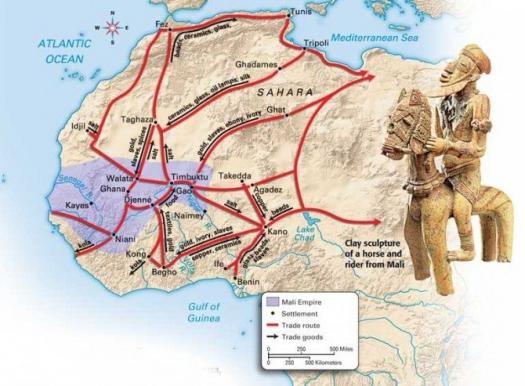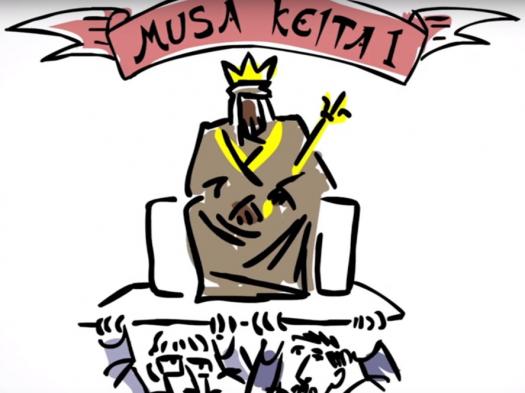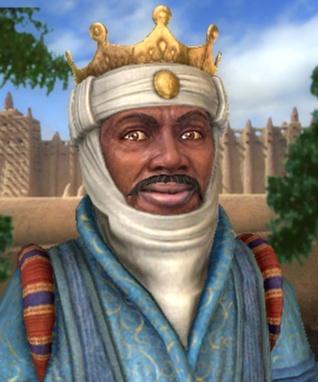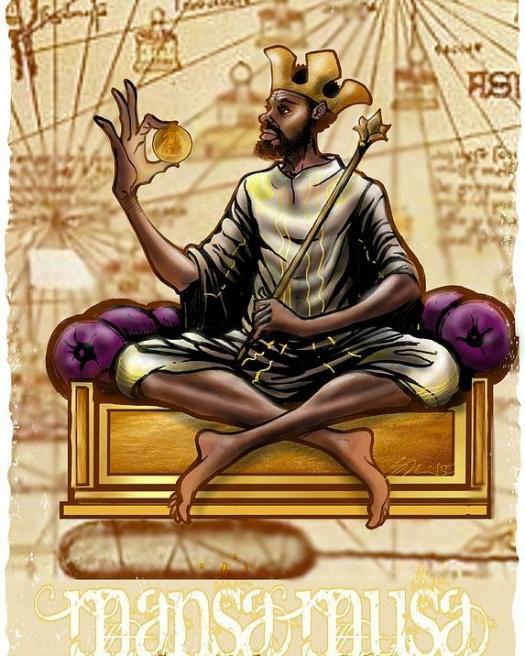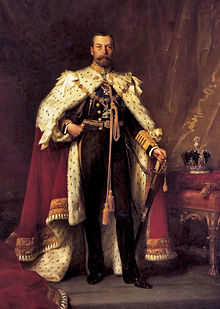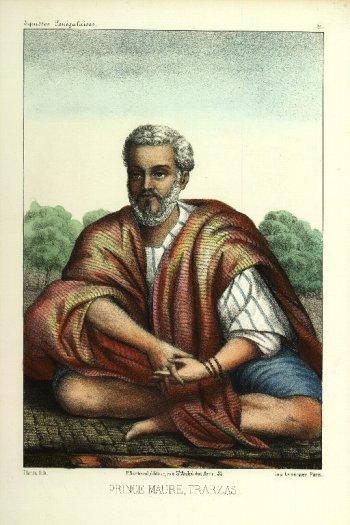What Do You Know About Mansa Musa The Richest?
-
During the 14th century, Mansa Musa ruled over whichempire?
-
Mali
-
Morocco
-
Madagascar
-
Malta
-
According to history, Mansa Musa was the wealthiest man ever lived, whose riches in the fourteenth century would equal almost $400 billion today. Try out this quiz to know more about Mansa Musa.

Quiz Preview
- 2.
Which city turned into a worldwide center of culture and learning as a result of Mansa Musa's influence?
-
Fez
-
Timbuktu
-
Alexandria
-
Mogadishu
Correct Answer
A. TimbuktuExplanation
Timbuktu turned into a worldwide center of culture and learning as a result of Mansa Musa's influence. Mansa Musa, the ruler of the Mali Empire in the 14th century, was a devout Muslim and went on a famous pilgrimage to Mecca. During his journey, he stopped in Cairo and impressed the scholars and intellectuals there with his wealth and generosity. As a result, many scholars from Cairo followed him back to Timbuktu, which became a hub for Islamic education and scholarship. Mansa Musa's influence and patronage helped Timbuktu flourish as a center of culture, learning, and trade in the region.Rate this question:
-
- 3.
Mansa Musa made a great fortune from the production of which of the following?
-
Gold and silks
-
Gold and cotton
-
Gold and salt
-
Silk and cotton
Correct Answer
A. Gold and saltExplanation
Mansa Musa made a great fortune from the production of gold and salt. Gold was abundant in the Mali Empire, and Mansa Musa controlled the region's gold mines, allowing him to accumulate vast wealth. Additionally, salt was a highly valuable commodity in West Africa during that time, as it was used for preserving food and as a form of currency. Mansa Musa's control over the salt trade routes further contributed to his wealth and power.Rate this question:
-
- 4.
How many men did Mansa Musa took along on his pilgrimage?
-
40,000
-
60,000
-
70,000
-
80,000
Correct Answer
A. 60,000Explanation
Mansa Musa took 60,000 men along on his pilgrimage. This indicates that he had a large entourage accompanying him during his journey. Having such a large number of men suggests that Mansa Musa was a wealthy and powerful ruler, as only someone of his stature would be able to gather such a significant group of people for a pilgrimage.Rate this question:
-
- 5.
What year did Mansa Musa undertook the 2500 mile overland trip to Mecca?
-
1327
-
1340
-
1324
-
1350
Correct Answer
A. 1324Explanation
In 1324, Mansa Musa undertook a 2500 mile overland trip to Mecca. This journey was significant as Mansa Musa, the ruler of the Mali Empire, was a devout Muslim and his pilgrimage to Mecca was a demonstration of his faith. It also allowed him to strengthen diplomatic and economic ties with other Muslim states along the way. Mansa Musa's pilgrimage is notable for the immense wealth he displayed, which greatly impressed the people he encountered and contributed to the spread of Mali's reputation as a prosperous empire.Rate this question:
-
- 6.
How long did it take Mansa Musa to complete the 2500 mile overland trip?
-
One year
-
Two years
-
Two months
-
Six months
Correct Answer
A. One yearExplanation
Mansa Musa took one year to complete the 2500 mile overland trip. This suggests that the journey was long and challenging, requiring a significant amount of time to complete. It also implies that Mansa Musa was determined and persistent in his endeavor, as he was able to successfully complete the trip within the given timeframe.Rate this question:
-
- 7.
Mansa Musa reigned in the empire for how many years?
-
25 years
-
30 years
-
35 years
-
40 years
Correct Answer
A. 25 yearsExplanation
Mansa Musa reigned in the empire for 25 years. This means that he held power and ruled over the empire for a quarter of a century. During his reign, Mansa Musa made significant contributions to the Mali Empire, including expanding its territory and promoting trade and education. His long reign allowed him to implement various reforms and establish a strong and prosperous empire.Rate this question:
-
- 8.
Who succeeded the throne of Mansa Musa after his death?
-
Irani Kunate
-
Mansa Sulayman
-
Mansa Qu
-
Mansa Maghan
Correct Answer
A. Mansa MaghanExplanation
Mansa Maghan succeeded the throne of Mansa Musa after his death.Rate this question:
-
- 9.
What were the two primary symbols of power in Mansa Musa's empire?
-
Gold and Silk
-
Gold and Ivory
-
Gold and Silver
-
Gold and Horses
Correct Answer
A. Gold and HorsesExplanation
Mansa Musa's empire was known for its wealth and power, and two primary symbols of this power were gold and horses. Gold represented the empire's vast wealth and resources, while horses symbolized military strength and dominance. Horses were highly valued and played a crucial role in warfare and trade during that time. Therefore, the combination of gold and horses accurately represents the symbols of power in Mansa Musa's empire.Rate this question:
-
- 10.
What is the name of the university built by Mansa Musa in Timbuktu?
-
University of Sankore
-
University of Mali
-
University of Timbuktu
-
None of the above
Correct Answer
A. University of SankoreExplanation
Mansa Musa, the emperor of the Mali Empire, built the University of Sankore in Timbuktu. This university was a renowned center of learning and attracted scholars from all over the world. It had a large library and offered education in various fields such as Islamic theology, law, medicine, and mathematics. The University of Sankore played a significant role in the intellectual and cultural development of West Africa during the medieval period.Rate this question:
-
Quiz Review Timeline (Updated): Mar 21, 2023 +
Our quizzes are rigorously reviewed, monitored and continuously updated by our expert board to maintain accuracy, relevance, and timeliness.
-
Current Version
-
Mar 21, 2023Quiz Edited by
ProProfs Editorial Team -
Oct 28, 2017Quiz Created by
Jaksiboy
Lawmen: Bass Reeves Series Quiz Question & Answers
Welcome to the Lawmen: Bass Reeves Series Quiz! Are you ready to test your knowledge of this captivating American Western television miniseries? Dive into the world of Bass...
Questions:
10 |
Attempts:
22 |
Last updated:
Mar 04, 2024
|
Which Character From Rustin Movie Are You?
Step into the world of the Rustin movie, a cinematic journey that unravels the incredible story of Bayard Rustin, a charismatic gay civil rights activist. Set against the backdrop...
Questions:
10 |
Attempts:
13 |
Last updated:
Feb 08, 2024
|
Quiz: What Historical Figure Are You?
Are you more involved with famous historical figures? Do you often wonder which historical figure you would resemble? Embark on an intriguing exploration of self-discovery with...
Questions:
10 |
Attempts:
618 |
Last updated:
Dec 20, 2023
|
The Father Of Rocket Science: Wernher Von Braun Quiz Challenge
Prepare for liftoff with the "Father of Rocket Science: Wernher von Braun Quiz Challenge!" As the brilliant mind behind the development of the V-2 rocket and the Saturn...
Questions:
15 |
Attempts:
99 |
Last updated:
Oct 18, 2023
|
Can You Name These Historical Figures By The Image?
History is filled with some marvelous, influential people who changed the course of the world. Can you name these historical figures by just looking at the image? Prove yourself...
Questions:
10 |
Attempts:
605 |
Last updated:
Nov 16, 2023
|
Malika Tul Arab Lady Khadija Tul Kubra SA
Explore the life of Lady Khadija, the first wife of Prophet Muhammad (pbuh), focusing on her origins, family, and religious beliefs before Islam.
Questions:
25 |
Attempts:
580 |
Last updated:
Mar 21, 2023
|
 Back to top
Back to top




